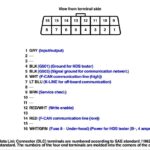Experiencing a no-start condition in your 2001 Mercury Cougar alongside a non-functional radio and OBD2 port can be frustrating and indicate potential electrical or sensor malfunctions. Instead of immediately resorting to part replacements, a systematic diagnostic approach is crucial to pinpoint the root cause of these issues. This guide will explore common culprits, particularly focusing on components like the crankshaft position sensor and related systems that might be affecting your Cougar.
One frequently cited issue for no-start problems is a faulty crankshaft position sensor. This sensor is vital as it monitors the crankshaft’s position and speed, information the engine control unit (ECU) relies on to manage ignition timing and fuel injection. If the crankshaft sensor fails, the ECU may not receive the necessary signals, leading to a no-start condition.
Symptoms of a failing crankshaft sensor can include:
- Engine cranks but does not start.
- Intermittent starting problems.
- Engine stalling.
- Check engine light illumination (though not always for crank sensor issues specifically until the engine runs).
It’s also important to consider the camshaft position sensor. While the crankshaft sensor is critical for ignition timing, the camshaft sensor works in conjunction to provide the ECU with comprehensive data on engine timing. A malfunctioning camshaft sensor can also contribute to no-start conditions or poor engine performance.
Beyond sensors, timing issues should not be overlooked. A timing belt or chain that has jumped a tooth, especially after the engine is shut off, can disrupt the synchronization between the crankshaft and camshaft. This misalignment can prevent the engine from starting as the valves and pistons are no longer operating in the correct sequence.
Now, addressing the radio and OBD2 port issues in conjunction with the no-start problem suggests a potential broader electrical problem. Both the radio and OBD2 port rely on the car’s electrical system for power and functionality. If these are not working, it could indicate:
- Fuse issues: Check fuses related to the radio, OBD2 port, and engine management system. A blown fuse could disable these systems.
- Wiring problems: Inspect wiring harnesses for damage, corrosion, or loose connections, particularly those related to the ECU, radio, and OBD2 port.
- ECU malfunction: In rare cases, a failing ECU could be responsible for multiple system failures, including sensor readings, OBD2 port operation, and radio function.
Regarding the OBD2 port specifically, it’s important to note that some diagnostic codes, such as those related to the crankshaft sensor, might not be immediately apparent until the engine is running. The ECU’s diagnostic routines are designed to detect certain faults during engine operation.
Diagnostic Steps:
- Check Fuses: Begin by inspecting the fuses related to the radio, OBD2 port, and engine control system. Replace any blown fuses.
- Inspect Wiring: Carefully examine wiring harnesses and connectors for any signs of damage or corrosion, especially around the ECU, radio, and OBD2 port areas.
- Crankshaft and Camshaft Sensor Testing: Use a multimeter to test the resistance and signal output of both the crankshaft and camshaft sensors. Refer to your 2001 Cougar repair manual for specific testing procedures and values.
- Timing Belt/Chain Inspection: If sensor tests are inconclusive, consider inspecting the timing belt or chain for proper tension and alignment. This may require removing valve covers or timing covers for visual inspection.
- Professional Scan: If you can get the OBD2 port working (after fuse/wiring checks), use an OBD2 scanner to check for any stored trouble codes. Even if the port is not working, a professional mechanic with advanced diagnostic tools can perform deeper electrical system checks.
Conclusion:
Dealing with a 2001 Cougar that won’t start and has radio and OBD2 port malfunctions requires a methodical approach. While crankshaft and camshaft sensors are common culprits for no-start issues, the additional radio and OBD2 port problems point towards potential electrical system faults. Avoid unnecessary part swapping and prioritize a step-by-step diagnostic process, starting with fuse and wiring inspections, sensor testing, and potentially timing component checks. If you’re uncomfortable performing these tests, seeking assistance from a qualified automotive technician is highly recommended to accurately diagnose and resolve these complex issues. Remember, the OBD2 system and ECU are tools to aid in diagnosis, but a comprehensive understanding of automotive systems is key to effective repair.
